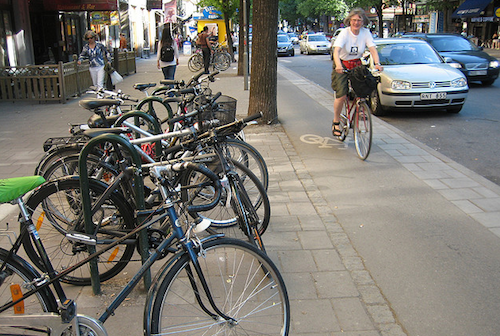Streets, in theory, belong to everyone. But in most instances, cars dominate them, leaving cyclists and pedestrians to make do with what little space cars aren’t using. The Complete Streets movement works to change that.
A transportation policy and design approach, Complete Streets ensure that streets are safe and accessible for all users, including cyclists, public transportation, pedestrians of all ages and abilities, and cars. In a nutshell, Complete Street have features including pedestrian sidewalks and crosswalks, traffic calming infrastructure, protected bike lanes, and mass transit accommodations such as bus pullouts and shelters.
A recent study, conducted by the National Complete Streets Coalition, found that in 2012, nearly 130 communities adopted Complete Streets policies. 488 Complete Streets policies are now in place across the U.S., at all levels of government. The Coalition looked at all the new Complete Streets policies and scored them based on factors including vision and intent, usability, inclusion of all users, design, and implementation. Their findings are available in the report, The Best Complete Streets Policies of 2012. Here are the top scoring communities:
1. Indianapolis, IN
2. Hermosa Beach, CA
3. Huntington Park, CA
4. Ocean Shores, WA
5. Northfield, MN
6. Portland, ME
7. Oak Park, IL
8. Trenton, NJ
9. Clayton, MO
10. Rancho Cucamonga, CA
Most of the Complete Streets policies are written in policy-speak (Resolution No. 2083-11, anyone?) and completely glaze over the eyes of the uninitiated, but the idea is that they all illustrate a commitment by government officials to adhere to Complete Streets guidelines. Here are some examples:
Portland, ME
The Department of Public Services and the Department of Planning and Urban Development shall adapt, develop and adopt inter-departmental policies, urban design guidelines, zoning and performance standards and other guidelines based upon resources identifying best practices in urban design and street design, construction, operations and maintenance.
Indianapolis, IN
The City shall measure the success of this Complete Streets policy using, but not limited to, the following performance measures:
- Total miles of bike lanes
- Linear feet of new pedestrian accommodation
- Number of new curb ramps installed along city streets
- Crosswalk and intersection improvements
- Percentage of transit stops accessible via sidewalks and curb ramps (beginning in June 2014)
- Rate of crashes, injuriesand fatalities by mode
- Rate of children walking or bicycling to school (beginning in June 2014)
Huntington Park, CA
The City of Huntington Park will design, operate and maintain a transportation network that provides a connected network of facilities accommodating all modes of travel… will actively look for opportunities to repurpose rights-of-way to enhance connectivity for pedestrians, bicyclists and transit…will require new developments to provide interconnected street networks with small blocks.
Do you have Complete Streets in your community? We’d love to hear your experience with them. Would you like to learn more about the movement? Here are some resources to get you started, including a link to download the complete report and a video on the Complete Streets movement.
- National Complete Streets Coalition
- Best Complete Street Policies of 2012 Study
- Complete Streets Local Policy Workbook
- Complete Streets at Wikipedia









